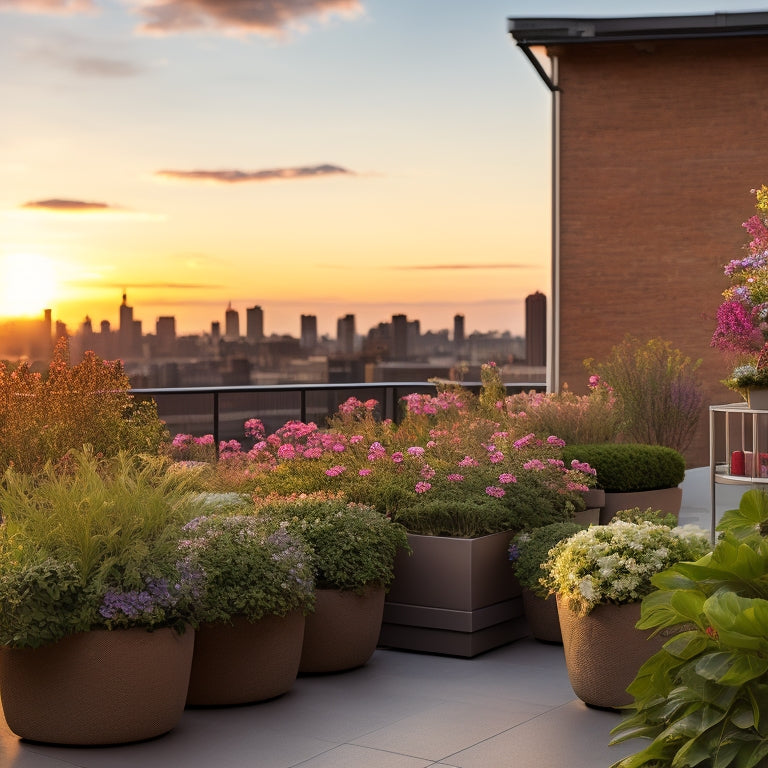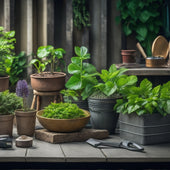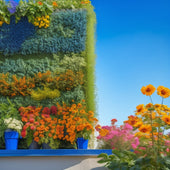
7 Essential Tips for Rooftop Gardening in Small Spaces
Share
As you begin your journey into rooftop gardening in small spaces, you'll need to carefully assess your rooftop's unique conditions, considering sunlight exposure, wind direction, and structural integrity. Next, choose compact plants wisely, selecting varieties that thrive in small spaces, like dwarf citrus trees and trailing plants. Opt for space-saving containers that maximize vertical space, and optimize sunlight and shade by orienting plants eastward and using trellises. Water efficiently and safely using drip irrigation systems, and implement vertical gardening methods like living wall planters and arbors. By following these essential tips, you'll be well on your way to creating a thriving rooftop garden, and there's more to explore to take your garden to new heights.
Key Takeaways
• Assess rooftop conditions, including sunlight, wind, and structural integrity, to ensure a safe and thriving garden.
• Choose compact, low-maintenance plants and utilize space-saving containers to maximize vertical space.
• Optimize sunlight and shade by orienting plants eastward and using trellises or vertical planters for upward growth.
• Implement efficient watering techniques, such as drip irrigation and rainwater harvesting, to conserve water resources.
• Regularly inspect and maintain the rooftop garden, including pruning, fertilizing, and pest control, to promote healthy plant growth.
Assess Your Rooftop's Potential
Regularly inspect your rooftop's conditions to determine its suitability for a garden, considering factors such as sunlight exposure, wind direction, and structural integrity.
Take note of the rooftop's slope, as a steeper incline may require additional support for your garden. Evaluate the rooftop's material, ensuring it can withstand the weight of your garden, including soil, plants, and water. Weight considerations are vital, as excessive weight can compromise rooftop safety.
Measure the rooftop's dimensions to determine the available space for your garden. Consider the location of vents, skylights, and other obstructions that may impact your garden's layout. Review the rooftop's drainage system, ensuring it can efficiently handle water runoff. A well-functioning drainage system is essential to prevent waterlogged soil and structural damage.
Lastly, inspect the rooftop's access points, ensuring safe and convenient entry and exit points for maintenance and harvesting. By thoroughly evaluating your rooftop's conditions, you'll be able to create a safe and thriving garden that meets your needs and enhances your outdoor space.
Choose Compact Plants Wisely
With your rooftop's conditions assessed, you can now focus on selecting compact plants that will thrive in your carefully planned garden, taking into account the unique challenges and opportunities presented by your rooftop's microclimate.
When choosing plants, remember that compact doesn't mean sacrificing beauty or functionality. You can still have a visually stunning garden with a variety of herb selection and flower varieties.
Here are some key considerations for selecting compact plants:
-
Dwarf or compact varieties: Look for plants bred specifically for small spaces or containers, such as dwarf citrus trees or compact herb varieties like basil or rosemary.
-
Trailing plants: Plants like creeping thyme or sweet potato vine can spill over containers, adding visual interest without taking up too much space.
-
Upright growers: Plants like columnar apple trees or compact flower varieties like petunias or geraniums grow upwards, maximizing vertical space.
- Low-maintenance plants: Choose plants that require minimal care, such as succulents or air plants, to guarantee your rooftop garden remains healthy and thriving.
Select Space-Saving Containers
When selecting space-saving containers for your rooftop garden, you'll want to prioritize compact planters that maximize vertical space.
Consider options like tiered planters, hanging baskets, or wall-mounted pockets that optimize your rooftop's spatial constraints.
Compact Planters Ideal
You'll need to choose compact planters that maximize vertical space, such as tiered or stacked containers, to make the most of your rooftop garden's limited area.
This is especially important for herb gardening, where you want to make the most of your space. By selecting the right containers, you can create a thriving container gardening setup even in a small rooftop space.
When selecting compact planters, consider the following:
-
Depth: Look for planters with a shallow depth to accommodate herbs and other small plants.
-
Width: Choose planters that are narrow and long to fit snugly against walls or railings.
-
Material: Select planters made from lightweight, durable materials like plastic or fiberglass.
- Drainage: Guarantee your planters have built-in drainage holes to prevent waterlogged soil.
Vertical Gardening Options
Select space-saving containers that allow for upward growth, like trellises, arbors, or wall-mounted planters, to capitalize on your rooftop garden's vertical space. These containers will maximize your garden's potential while keeping the footprint small.
For a more dramatic effect, consider hanging planters that can be suspended from the rooftop's railing or a sturdy hook. This will add depth and visual interest to your garden.
When choosing a trellis system, opt for one that's sturdy and can support the weight of the plants as they grow. You can also train vining plants like ivy, clematis, or wisteria to climb up the trellis, creating a lush, verdant display.
Make sure to secure the trellis system firmly to the rooftop to prevent it from toppling over in the wind.
Optimize Sunlight and Shade
As you design your rooftop garden, you'll need to carefully consider the interplay of sunlight and shade.
You'll want to identify areas that receive morning sun exposure, which can be ideal for certain plants, and also pinpoint shaded areas that can benefit from carefully selected shade-tolerant species.
Morning Sun Exposure
Morning sunlight, streaming through the eastern side of your rooftop garden, provides an excellent opportunity to capitalize on gentle, indirect rays that foster healthy plant growth. As you start your morning routines, take note of the sun's positioning and how it affects your plants. By understanding the movement of the sun, you can strategically place your plants to maximize their exposure to morning sunlight.
Here are some key considerations to keep in mind:
-
Orient plants eastward: Place plants on the eastern side of your rooftop garden to capture the gentle morning sunlight, which is excellent for plants that require indirect light.
-
Use trellises or vertical planters: Train vining plants to grow upwards, making the most of the available space and morning sunlight.
-
Group plants by sunlight needs: Segment your rooftop garden into zones based on the amount of sunlight required by each plant, making sure that those that need morning sunlight receive it.
- Monitor and adjust: Observe how the morning sunlight affects your plants and adjust their positioning as needed to guarantee maximum growth.
Shaded Areas Benefit
By cleverly optimizing the interplay between sunlight and shade, you can turn shaded areas of your rooftop garden into thriving oases that support a diverse range of plant life.
Shaded areas can be a blessing in disguise, as they provide a unique opportunity to create a microclimate that's perfect for shaded plants.
These plants, such as ferns and peace lilies, thrive in low-light conditions and can add a touch of elegance to your rooftop garden.
Balancing Light Needs
You'll need to strategically allocate sunlight and shade to satisfy the varying light requirements of your rooftop garden's diverse plant species. This delicate balance is vital, as excessive light can scorch plants, while insufficient light can hinder growth. To achieve ideal light distribution, consider the following:
-
Assess light intensity: Measure the amount of direct sunlight your rooftop receives throughout the day, taking into account seasonal changes. This will help you identify areas that require shade or additional sunlight.
-
Utilize shade-providing structures: Install trellises, arbors, or canopies to create dappled shade, perfect for plants that thrive in partial sunlight.
-
Group plants by light requirements: Segregate plants based on their light needs, ensuring those that require intense sunlight are placed in areas that receive direct radiation.
- Monitor and adjust: Regularly observe your plants' responses to light conditions and make adjustments as needed to maintain a balanced environment.
Water Efficiently and Safely
Every rooftop garden requires a thoughtful watering strategy to conserve this precious resource and prevent waterlogged soil, structural damage, and even safety hazards.
You'll want to guarantee your rooftop garden is equipped with a reliable drainage system to prevent water accumulation. This can be achieved by installing a waterproof membrane, sloping the roof to facilitate runoff, and incorporating drainage channels or scuppers.
When it comes to irrigation techniques, consider using a drip irrigation system or soaker hose to deliver water directly to the roots of your plants, reducing evaporation and runoff. You can also implement rainwater harvesting systems to collect and store rainwater for later use.
Additionally, use water-efficient plants and mulch to reduce water loss through evaporation. By implementing these strategies, you'll be able to conserve water, prevent water-related issues, and create a thriving rooftop garden that's both sustainable and safe.
Use Vertical Gardening Methods
To maximize space and add visual interest to your rooftop garden, consider incorporating vertical gardening methods, such as trellises, arbors, or living walls, that allow plants to grow upwards and outwards. These structures provide support for climbing plants, which can thrive in small spaces and add texture, color, and depth to your garden.
When choosing a vertical gardening method, consider the following:
-
Select climbing plants that are suitable for your climate and rooftop conditions, such as ivy, clematis, or morning glories.
-
Install a trellis system that provides adequate support for your plants and can withstand wind and weather conditions.
-
Use a living wall planter that has built-in irrigation and drainage systems to guarantee healthy plant growth.
- Train your plants to grow upwards and outwards by pruning and guiding them along the trellis or arbor.
Maintain Regular Rooftop Care
With your vertical gardening methods in place, inspect your rooftop garden regularly to confirm its overall health and longevity. Regular care guarantees your plants thrive, and you can enjoy a bountiful harvest. It's crucial to stay on top of maintenance tasks to prevent issues from escalating.
Here's a breakdown of tasks to focus on:
| Task | Frequency | Description |
|---|---|---|
| Watering | Daily/Weekly | Check soil moisture, water plants, and confirm proper drainage. |
| Pruning | Weekly/Bi-Weekly | Trim plants to maintain shape, promote growth, and encourage fruiting. |
| Pest Management | Bi-Weekly | Inspect for signs of pests, and treat promptly to prevent infestations. |
| Seasonal Maintenance | Quarterly | Rotate plants, add new soil, and perform deep watering to refresh your garden. |
| Fertilization | Monthly | Feed your plants with a balanced fertilizer to support healthy growth. |
Frequently Asked Questions
Can Rooftop Gardens Attract Pests and Rodents to My Home?
As you tend to your rooftop oasis, beware of the unwanted guests it may attract; pests and rodents can be a real threat, but with strategic pest management and rodent prevention measures, you'll keep them at bay.
How Do I Ensure Rooftop Garden Weight Doesn't Compromise My Roof?
You'll need to calculate your rooftop garden's weight, considering soil types and their water retention, then implement drainage solutions like built-in gutters and waterproof membranes to prevent waterlogged soil from compromising your roof's structural integrity.
Are Rooftop Gardens Susceptible to Strong Wind Damage?
You'll need to take into account wind protection to prevent damage; guarantee your rooftop garden's structural stability by securing planters, using wind-resistant materials, and anchoring trellises to withstand gusts and maintain a safe, thriving oasis.
Can I Use Artificial Turf as a Rooftop Garden Base Layer?
You can use artificial turf as a rooftop garden base layer, leveraging its benefits like low maintenance and weight reduction, but make certain you pair it with effective drainage solutions, such as a permeable underlayment, to prevent waterlogged soil.
Do Rooftop Gardens Increase My Home's Insurance Premiums?
As you plant your rooftop oasis, a storm cloud of uncertainty looms: will your insurance premiums bloom like a weed? Typically, yes, you'll see an increase in premium rates, but the extent depends on your insurance coverage and policy fine print.
Related Posts
-

5 Best Trowels for Planting in Concrete Planters
When planting in concrete planters, you need a trowel that can handle the harsh conditions and reduce fatigue on your...
-

5 Best Trowels for Planting in Concrete Planters
When planting in concrete planters, you need a trowel that can handle the harsh conditions and reduce fatigue on your...
-

5 Best Trowels for Planting in Concrete Planters
When planting in concrete planters, you need a trowel that can handle the harsh conditions and reduce fatigue on your...
-

5 Best Trowels for Planting in Concrete Planters
When planting in concrete planters, you need a trowel that can handle the harsh conditions and reduce fatigue on your...
-

5 Best Trowels for Planting in Concrete Planters
When planting in concrete planters, you need a trowel that can handle the harsh conditions and reduce fatigue on your...
-

5 Best Trowels for Planting in Concrete Planters
When planting in concrete planters, you need a trowel that can handle the harsh conditions and reduce fatigue on your...
-

5 Best Trowels for Planting in Concrete Planters
When planting in concrete planters, you need a trowel that can handle the harsh conditions and reduce fatigue on your...
-

5 Best Trowels for Planting in Concrete Planters
When planting in concrete planters, you need a trowel that can handle the harsh conditions and reduce fatigue on your...
-

5 Best Trowels for Planting in Concrete Planters
When planting in concrete planters, you need a trowel that can handle the harsh conditions and reduce fatigue on your...
-

5 Best Trowels for Planting in Concrete Planters
When planting in concrete planters, you need a trowel that can handle the harsh conditions and reduce fatigue on your...
-

5 Best Trowels for Planting in Concrete Planters
When planting in concrete planters, you need a trowel that can handle the harsh conditions and reduce fatigue on your...
-

5 Best Trowels for Planting in Concrete Planters
When planting in concrete planters, you need a trowel that can handle the harsh conditions and reduce fatigue on your...
-

5 Best Trowels for Planting in Concrete Planters
When planting in concrete planters, you need a trowel that can handle the harsh conditions and reduce fatigue on your...
-

5 Best Trowels for Planting in Concrete Planters
When planting in concrete planters, you need a trowel that can handle the harsh conditions and reduce fatigue on your...
-

5 Best Trowels for Planting in Concrete Planters
When planting in concrete planters, you need a trowel that can handle the harsh conditions and reduce fatigue on your...
-

5 Best Trowels for Planting in Concrete Planters
When planting in concrete planters, you need a trowel that can handle the harsh conditions and reduce fatigue on your...
-

5 Best Trowels for Planting in Concrete Planters
When planting in concrete planters, you need a trowel that can handle the harsh conditions and reduce fatigue on your...
-

5 Best Trowels for Planting in Concrete Planters
When planting in concrete planters, you need a trowel that can handle the harsh conditions and reduce fatigue on your...
-

Why Do Cinder Block Planter Tools Cost So Much
You'll likely spend at least $200 to $500 on essential tools for a DIY cinder block planter project, with high-end op...
-

Why Do Cinder Block Planter Tools Cost So Much
You'll likely spend at least $200 to $500 on essential tools for a DIY cinder block planter project, with high-end op...
-

Why Do Cinder Block Planter Tools Cost So Much
You'll likely spend at least $200 to $500 on essential tools for a DIY cinder block planter project, with high-end op...
-

Why Do Cinder Block Planter Tools Cost So Much
You'll likely spend at least $200 to $500 on essential tools for a DIY cinder block planter project, with high-end op...
-

Why Do Cinder Block Planter Tools Cost So Much
You'll likely spend at least $200 to $500 on essential tools for a DIY cinder block planter project, with high-end op...
-

Why Do Cinder Block Planter Tools Cost So Much
You'll likely spend at least $200 to $500 on essential tools for a DIY cinder block planter project, with high-end op...
-

Why Do Cinder Block Planter Tools Cost So Much
You'll likely spend at least $200 to $500 on essential tools for a DIY cinder block planter project, with high-end op...
-

Why Do Cinder Block Planter Tools Cost So Much
You'll likely spend at least $200 to $500 on essential tools for a DIY cinder block planter project, with high-end op...
-

Why Do Cinder Block Planter Tools Cost So Much
You'll likely spend at least $200 to $500 on essential tools for a DIY cinder block planter project, with high-end op...
-

Why Do Cinder Block Planter Tools Cost So Much
You'll likely spend at least $200 to $500 on essential tools for a DIY cinder block planter project, with high-end op...
-

Why Do Cinder Block Planter Tools Cost So Much
You'll likely spend at least $200 to $500 on essential tools for a DIY cinder block planter project, with high-end op...
-

Why Do Cinder Block Planter Tools Cost So Much
You'll likely spend at least $200 to $500 on essential tools for a DIY cinder block planter project, with high-end op...
-

Why Do Cinder Block Planter Tools Cost So Much
You'll likely spend at least $200 to $500 on essential tools for a DIY cinder block planter project, with high-end op...
-

Why Do Cinder Block Planter Tools Cost So Much
You'll likely spend at least $200 to $500 on essential tools for a DIY cinder block planter project, with high-end op...
-

Why Do Cinder Block Planter Tools Cost So Much
You'll likely spend at least $200 to $500 on essential tools for a DIY cinder block planter project, with high-end op...
-

Why Do Cinder Block Planter Tools Cost So Much
You'll likely spend at least $200 to $500 on essential tools for a DIY cinder block planter project, with high-end op...
-

Why Do Cinder Block Planter Tools Cost So Much
You'll likely spend at least $200 to $500 on essential tools for a DIY cinder block planter project, with high-end op...
-

Why Do Cinder Block Planter Tools Cost So Much
You'll likely spend at least $200 to $500 on essential tools for a DIY cinder block planter project, with high-end op...
-

Why Do Cinder Block Planter Tools Cost So Much
You'll likely spend at least $200 to $500 on essential tools for a DIY cinder block planter project, with high-end op...
-

Why Do Cinder Block Planter Tools Cost So Much
You'll likely spend at least $200 to $500 on essential tools for a DIY cinder block planter project, with high-end op...
-

Why Do Cinder Block Planter Tools Cost So Much
You'll likely spend at least $200 to $500 on essential tools for a DIY cinder block planter project, with high-end op...
-

Why Do Cinder Block Planter Tools Cost So Much
You'll likely spend at least $200 to $500 on essential tools for a DIY cinder block planter project, with high-end op...
-

Why Do Cinder Block Planter Tools Cost So Much
You'll likely spend at least $200 to $500 on essential tools for a DIY cinder block planter project, with high-end op...
-

Why Do Cinder Block Planter Tools Cost So Much
You'll likely spend at least $200 to $500 on essential tools for a DIY cinder block planter project, with high-end op...
-

Why Do Cinder Block Planter Tools Cost So Much
You'll likely spend at least $200 to $500 on essential tools for a DIY cinder block planter project, with high-end op...
-

Why Do Cinder Block Planter Tools Cost So Much
You'll likely spend at least $200 to $500 on essential tools for a DIY cinder block planter project, with high-end op...
-

Why Do Cinder Block Planter Tools Cost So Much
You'll likely spend at least $200 to $500 on essential tools for a DIY cinder block planter project, with high-end op...
-

Why Do Cinder Block Planter Tools Cost So Much
You'll likely spend at least $200 to $500 on essential tools for a DIY cinder block planter project, with high-end op...
-

Why Do Cinder Block Planter Tools Cost So Much
You'll likely spend at least $200 to $500 on essential tools for a DIY cinder block planter project, with high-end op...
-

Why Do Cinder Block Planter Tools Cost So Much
You'll likely spend at least $200 to $500 on essential tools for a DIY cinder block planter project, with high-end op...
-

Why Do Cinder Block Planter Tools Cost So Much
You'll likely spend at least $200 to $500 on essential tools for a DIY cinder block planter project, with high-end op...
-

5 Tips for Thriving Vertical Vegetable Gardens
To thrive in vertical vegetable gardening, you'll want to choose a planter that meets the unique needs of your veggie...
-

5 Tips for Thriving Vertical Vegetable Gardens
To thrive in vertical vegetable gardening, you'll want to choose a planter that meets the unique needs of your veggie...
-

5 Tips for Thriving Vertical Vegetable Gardens
To thrive in vertical vegetable gardening, you'll want to choose a planter that meets the unique needs of your veggie...
-

5 Tips for Thriving Vertical Vegetable Gardens
To thrive in vertical vegetable gardening, you'll want to choose a planter that meets the unique needs of your veggie...
-

5 Tips for Thriving Vertical Vegetable Gardens
To thrive in vertical vegetable gardening, you'll want to choose a planter that meets the unique needs of your veggie...
-

5 Tips for Thriving Vertical Vegetable Gardens
To thrive in vertical vegetable gardening, you'll want to choose a planter that meets the unique needs of your veggie...
-

5 Tips for Thriving Vertical Vegetable Gardens
To thrive in vertical vegetable gardening, you'll want to choose a planter that meets the unique needs of your veggie...
-

5 Tips for Thriving Vertical Vegetable Gardens
To thrive in vertical vegetable gardening, you'll want to choose a planter that meets the unique needs of your veggie...
-

5 Tips for Thriving Vertical Vegetable Gardens
To thrive in vertical vegetable gardening, you'll want to choose a planter that meets the unique needs of your veggie...
-

5 Tips for Thriving Vertical Vegetable Gardens
To thrive in vertical vegetable gardening, you'll want to choose a planter that meets the unique needs of your veggie...
-

5 Tips for Thriving Vertical Vegetable Gardens
To thrive in vertical vegetable gardening, you'll want to choose a planter that meets the unique needs of your veggie...
-

5 Tips for Thriving Vertical Vegetable Gardens
To thrive in vertical vegetable gardening, you'll want to choose a planter that meets the unique needs of your veggie...
-

5 Tips for Thriving Vertical Vegetable Gardens
To thrive in vertical vegetable gardening, you'll want to choose a planter that meets the unique needs of your veggie...
-

5 Tips for Thriving Vertical Vegetable Gardens
To thrive in vertical vegetable gardening, you'll want to choose a planter that meets the unique needs of your veggie...
-

5 Tips for Thriving Vertical Vegetable Gardens
To thrive in vertical vegetable gardening, you'll want to choose a planter that meets the unique needs of your veggie...
-

5 Tips for Thriving Vertical Vegetable Gardens
To thrive in vertical vegetable gardening, you'll want to choose a planter that meets the unique needs of your veggie...
-

5 Tips for Thriving Vertical Vegetable Gardens
To thrive in vertical vegetable gardening, you'll want to choose a planter that meets the unique needs of your veggie...


